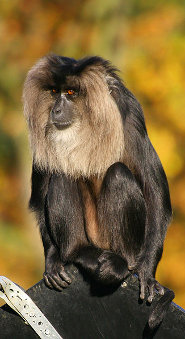The Lion-Tailed Macaque - A Crying Old Man
 The liontail macaque (Macaca silenus) is known to German speakers as the “Beard Ape.” This nomenclature, describes the silver-colored mane that encircles the lion-tailed macaque’s face. Aside from this mane, the rest of its appearance is dark. The hair is either a very dark brown or black, and the face is black. Thus, the beard resembles the grey beard of an old man with dark hair.
The liontail macaque (Macaca silenus) is known to German speakers as the “Beard Ape.” This nomenclature, describes the silver-colored mane that encircles the lion-tailed macaque’s face. Aside from this mane, the rest of its appearance is dark. The hair is either a very dark brown or black, and the face is black. Thus, the beard resembles the grey beard of an old man with dark hair.The lion-tailed macaque measures from 45 to 60 cm. (17 to 24 in.) and has a tail of around 25 cm. (10 in.). Their weight is between 3 and 10 kg. (7 to 22 lbs.). At zoos, these macaques can reach ages upwards of 30 years old, but in their natural habitat the life expectancy of a lion-tailed macaque is shortened to 20 years.
Living along the western coast of India, these monkeys are naturally found in Karnataka, Kerala and Tamil Nadu. Researchers believe that approximately 30,000 to 35,000 lion-tailed macaques can be found in this region. Due to this small population and the small geographical area they are found in, these primates are classified as endangered.
The endangered classification of lion-tailed macaques has been a tenuous issue over the past few decades. From 1977 to 1980, India’s main environmental debate was over the region of these monkeys. Thankfully, they have survived, mostly because of a strong public effort to save them. A little over a decade later, in the mid-1990s, fourteen troops of lion-tailed macaques were observed in the valley that was so fiercely fought over earlier. In the surrounding areas, several smaller, but self-sustaining, groups have been discovered.
The lion-tailed macaque enjoys the rain forests of this area of India. Although they prefer to eat the plants, invertebrates, insects and small vertebrates native to this part of India, the lion-tailed macaque can adapt to a wide variety of food sources.
When predators invade the territory, the lion-tailed macaque first screams loudly. If this does not succeed, then the macaques bawl equally as emotionally. In these situations, the lion-tailed macaque looks like a little old man, who lost a toy, crying loudly.
Tags used in this posting
Other entries about 'asia'
- Nilgai -- The Horse-like, Camel-like Antelope
- Javan langur -- The Monkey With a Mane
- Doria's tree-kangaroo
- Douc Langur - Endangered Colorful Asian Monkey
- Banded Hare-wallaby - Endangered Marsupial Nearly Wiped Out By Cats
- European Snow Vole - Vole with the Smallest Litters
- The Northern Chinese Flying Squirrel - The Squirrel with the Medicinal Dung
- White-throated Rock-thrush - the Little Snail-Cracker
- Daurian Hedgehog - Rare Russian Hedgehog Almost Wiped Out By Pesticides
- Greater Mouse Deer - Gives Peek at What Extinct Animals Were Like
- Kulan - Last Wild Donkey that Refuses to be Tamed
- The Japanese Macaque - Hot Springs-Loving Similian
- The Tibetan Fox - Silent Stalker of the Steppes
- Tiger - Largest cat killed by Chinese medicine?
- Puma - America's allrounder
- Proboscis monkey - The swimming star with the giant nose
- Lynx
- Indian rhinoceros - Rhino of the Asian riverscapes
Other entries about 'primates'
- Gerp’s Mouse Lemur - Primate Discovered in 2012
- The Japanese Macaque - Hot Springs-Loving Similian
- Tonkean Macaque - Social Creatures
- Gray-backed Sportive Lemur
- Cotton-top Tamarin - Rock Star of the Forest
- The Calabar Anwantibo - Nature's Hanging Lover
- Proboscis monkey - The swimming star with the giant nose
- Patas monkey - Racing guenons of the African savannahs
- Crested gibbon - At home in the top of the trees
Add your thoughts about this animal:
